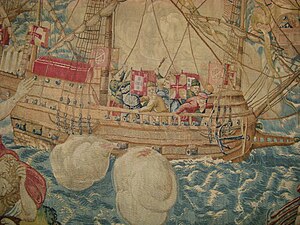| This article relies largely or entirely on a single source. Relevant discussion may be found on the talk page. Please help improve this article by introducing citations to additional sources. Find sources: "São João Baptista" galleon – news · newspapers · books · scholar · JSTOR (April 2020) |
 Detail of a tapestry depicting the São João Detail of a tapestry depicting the São João
| |
| History | |
|---|---|
| Name | São João Baptista |
| Builder | Kingdom of Portugal |
| Laid down | 29 August 1533 |
| Launched | 24 June 1534 |
| Out of service | 1551 |
| Fate | Broken up, 1551 |
| General characteristics | |
| Class and type | Galleon |
| Tons burthen | 1,000 tons |
| Armament | 366 guns |
São João Baptista ([ˈsɐ̃w̃ ˈʒwɐ̃w̃ baˈtiʃ.tɐ], English: Saint John the Baptist), nicknamed Botafogo ("Spitfire"), was a Portuguese galleon built in the 16th century, around 1530, considered one of the biggest and most powerful Portuguese warships.
History
The exact date of its construction is unknown; the oldest known references to the vessel mention the "great galleon São João" sailing in a convoy to Guinea, under the command of Duarte Coelho in 1532, but it could be simply a galleon with the same name.
Friar Manuel Homem says that this galleon mounted 366 bronze pieces of artillery, including the ones that garrisoned the high castles of stern and bow. The pamphlet attributed to Doctor Jorge Coelho, which appears to have been written during the reign of King John III of Portugal, says that the galleon was built in Portas do Mar in Lisbon, by Master João Galego, father of Pedro Galego, being laid down on 29 August 1533 and 230 workers were employed in its construction, of which 30 worked on it daily, and launched on 24 June 1534. It also says that its keel had the length and a half of the largest carrack of India, and that it had five gun decks, with the same number of 366 guns.
The oldest known estimates regarding its armament range from 80 to 200 guns, including a large chase gun. It was among the earliest recorded vessels to have gun ports with lids, which were opened to expose the cannon as a show of firepower.
In 1533, King John III pondered sending the great vessel to Goa, the capital of Portuguese India, so as to reinforce the firepower of Portuguese fleets that operated in the Indian Ocean against the galleys, dhows, and junks of Asia, but Duarte Coelho advised him against it.
Capture of Tunis

The São João most famously distinguished itself during the Conquest of Tunis (1535), when it bombarded La Goletta fortress.
Besides the São João itself, a further 20 war caravels and 2 carracks, bearing a total of 1500 men (of which 515 were soldiers and 230 were artillery gunners) made up the Portuguese expedition. The entire fleet carried 598 guns in total, most of them small caliber (1 basilisco, 2 leões, 3 águias, 19 camelos, 21 esperas, 52 pedreiros, 150 falcões, 350 berços). Its captain was António de Saldanha, with Infante Luís, Duke of Beja, brother of John III, and brother-in-law of Charles V being in overall command of the expeditionary corps, the galleon being his flagship.
Emperor Charles V visited the galleon personally, and marveled at its construction quality and armaments, while Andrea Doria also inspected the vessel on the occasion and regarded it favorably for its strength and orderliness.
Decommissioning

In 1550, the by then "old and very famous galleon São João was dispatched to Brazil", along with a convoy of several merchant ships with supplies, in the aid of the nascent colony and city of Salvador, and the following year, it was dismantled in Pernambuco, its iron parts and ammunition salvaged by the colonists, according to a report by governor Tomé de Sousa to King John III of Portugal.
Botafogo in Rio de Janeiro
Main article: BotafogoOne member of the crew named João de Sousa Pereira Botafogo, a nobleman from the city of Elvas, became famous because he was the master gunner responsible for the ship's artillery batteries, earning the nickname "botafogo" ("kindler"), which he later added to his family name. Later, he went to live in the Portuguese colony of Brazil, fighting against the French and the local Tupi Indians. As a reward, the Portuguese Crown granted him some lands known today as Botafogo.
See also
Bibliography
- Batalhas e Combates da Marinha Portuguesa, Vol. II, pages 243/245 – from Saturnino Monteiro. Livraria Sá da Costa, 1st edition, 1991.
- Nobreza de Portugal e do Brasil – Vol. I, pages 382/384. Published by Zairol Lda., Lisbon 1989.
- O Galeão S. João (c. 1530-1551). Dados para uma monografia, José Virgílio Pissarra, in Fernando Oliveira e o Seu Tempo - Humanismo e Arte de Navegar no Renascimento Europeu (1450-1650), Cascais 1999.
References
- José Virgílio Pissarra: O galeão S. João (c. 1530-1551). Dados para uma monografia, Cascais 1999, p.222-223
- José Virgílio Pissarra: O galeão S. João (c. 1530-1551). Dados para uma monografia, Cascais 1999, p.202
- ^ Quintela, Inácio da Costa (1839). Anais da Marinha Portuguesa (in Portuguese). Lisbon: Lisbon Academy of Sciences. p. 410.
- ^ São Luís, Francisco de (1839). Lista de Alguns Artistas Portugueses (in Portuguese). Lisbon: Imprensa Nacional. p. 22.
- José Virgílio Pissarra: O galeão S. João (c. 1530-1551). Dados para uma monografia, Cascais 1999, p.193
- Pissarra, 1999, p.198.
- Pissarra, 1999, p.203.
- José Virgílio Pissarra: O galeão S. João (c. 1530-1551). Dados para uma monografia, Cascais 1999, p.196
- Pissarra, 1999, p.198.
- José Virgílio Pissarra: O galeão S. João (c. 1530-1551). Dados para uma monografia, Cascais 1999, p.203